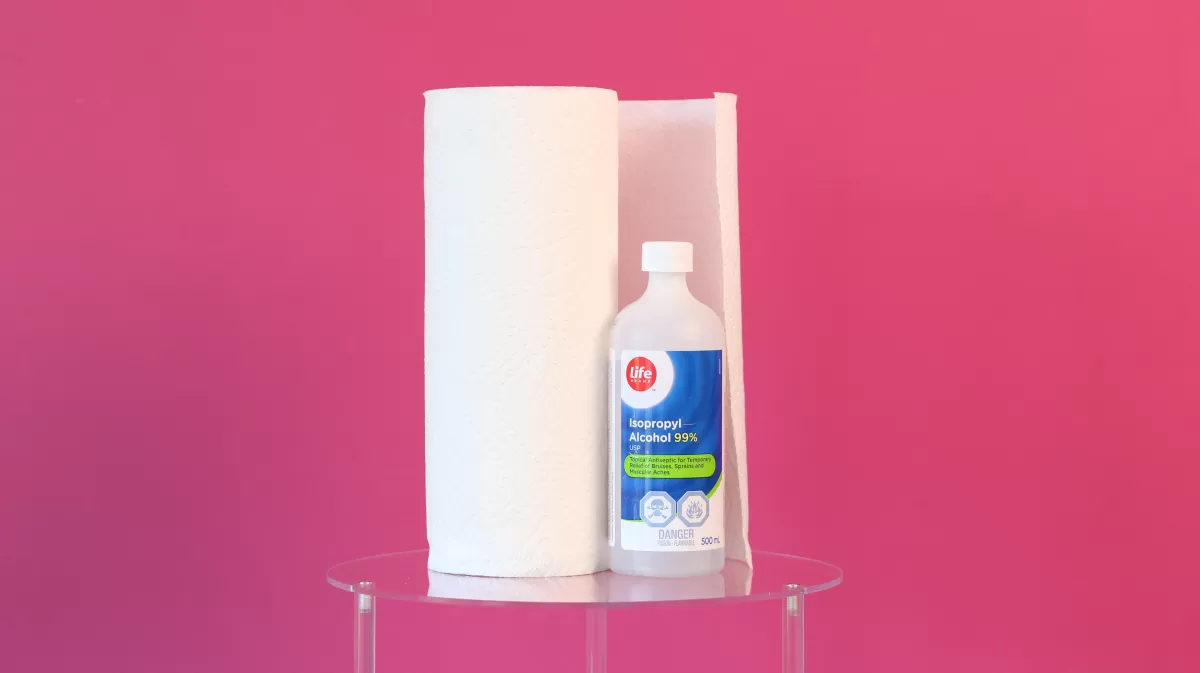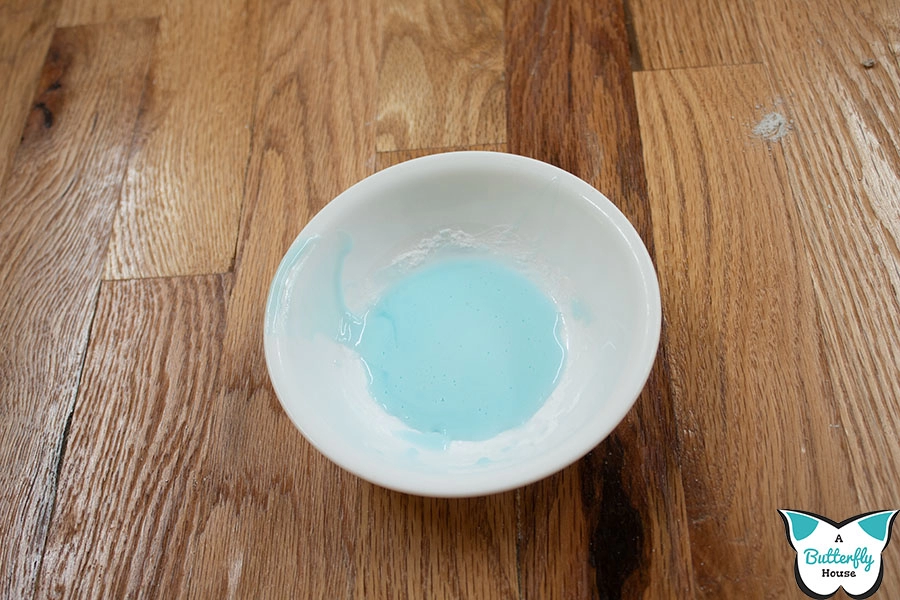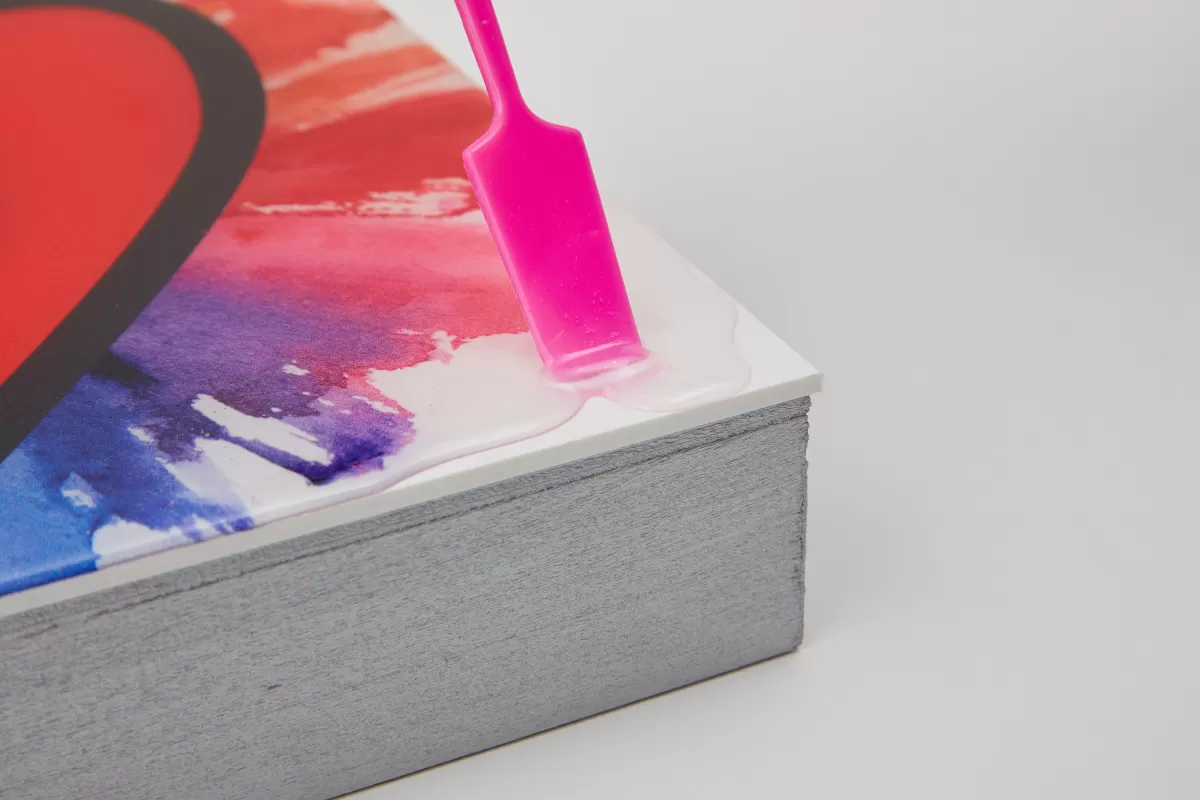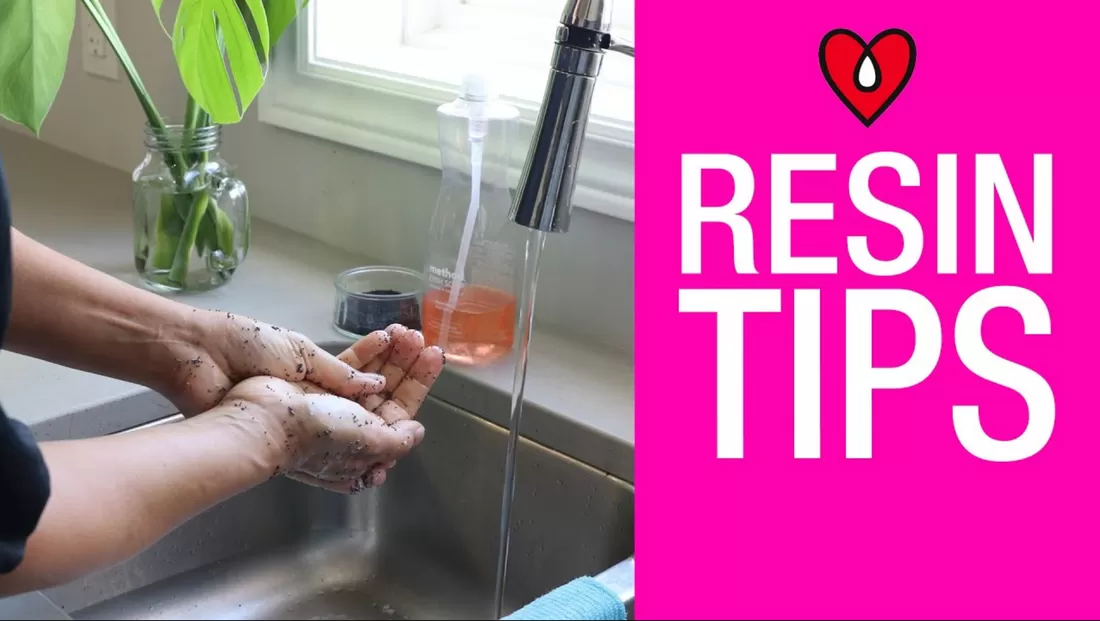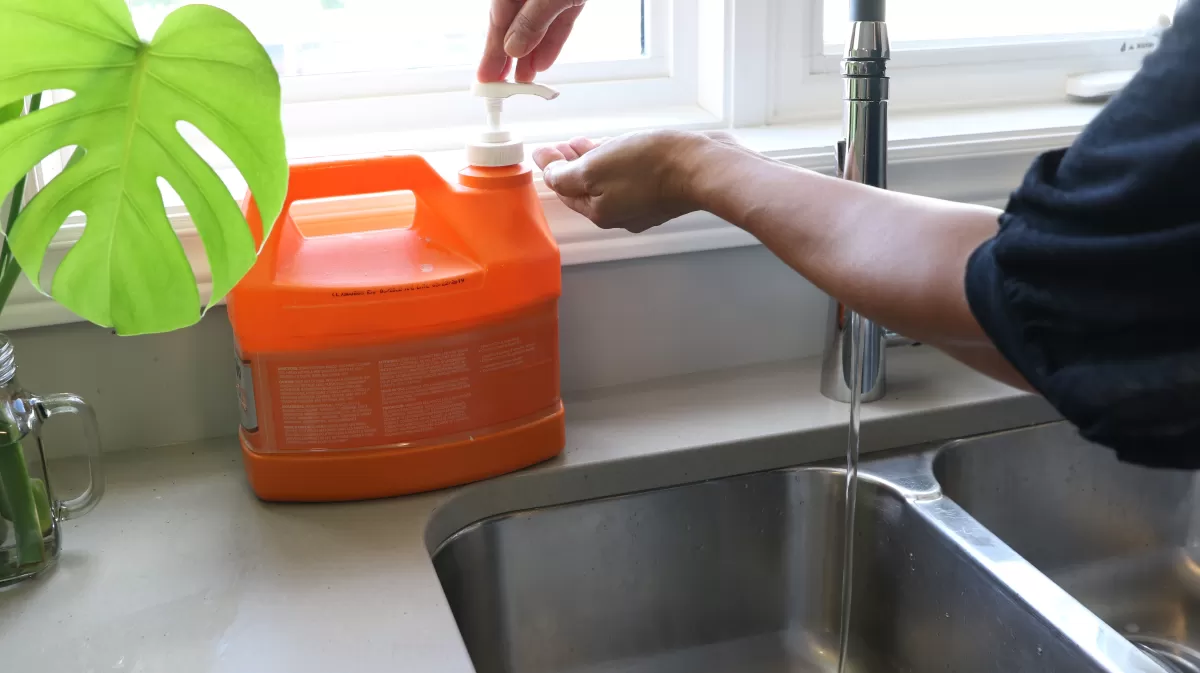Getting Resin Off Hands Safely with 7 Easy Removal Methods
Is resin stuck to your skin? Here’s how to remove it!
Resin is naturally sticky and tacky—it’s designed to bond firmly as it cures or hardens. Epoxy resin, for example, begins as a viscous liquid that cures into a solid plastic-like finish. This sticky nature is what makes epoxy versatile but also what causes it to cling to your skin. Similarly, UV resin remains tacky until exposed to UV light, which cures it quickly but means it can stick to your skin during handling.
Cannabis resin, often used in medicinal and recreational products, contains sticky plant oils and natural resins. Like synthetic resins, it adheres well to skin, creating a strong bond that can be tough to remove.
Why does this matter? Aside from the mess, resin on your hands can cause skin irritation, allergic reactions, or even chemical burns if left untreated. It’s important to understand this stickiness to prevent skin problems and know how to remove resin safely.
Must-see:
- Epoxy resin is sticky until fully cured making it cling to skin easily
- UV resin stays tacky until activated by light so it can stick during work
- Cannabis resin contains natural sticky resins and oils that adhere to skin
- Leaving resin on skin risks irritation and allergic reactions
Knowing this helps you handle resin with care and clean up effectively, which we’ll cover next. For those using resin with silicone molds check out how to prevent resin sticking in our resin in silicone mold guide.
Why Resin Sticks to Skin and Why It Matters
Risks of Leaving Resin on Skin
Resin sticks to skin because it’s sticky and often contains chemicals like epoxy or cannabis compounds that bond quickly. When resin lands on your hands, it can harden fast and become tough to remove. This is more than just a nuisance—leaving resin on your skin poses some real risks you should know about.
Skin Irritation and Allergic Reactions
Exposure to uncured resin can cause skin irritation, redness, itching, or even rashes. Some people are more sensitive and may develop allergic reactions, especially with repeated contact. Resin contains substances like hardeners and solvents that can disrupt your skin’s protective barrier.
Chemical Absorption
Resins, especially epoxy types, may contain chemicals that your skin can absorb if resin stays on for too long. This absorption might lead to more serious health concerns in the long run, such as irritation deeper in the skin or systemic effects.
Risks of Infection
If resin cracks on your skin or causes small cuts, it may trap bacteria and increase the risk of infection. Resin’s sticky texture can prevent wounds from healing properly or staying clean.
Impact on Daily Activities
Leaving resin on your hands makes them sticky, which can cause accidental transfer to other surfaces or objects. This can ruin clothes, electronics, or furniture, and spread the resin where you don’t want it.
Removing resin promptly and safely is important to protect your skin and avoid discomfort or harm. I’ll guide you through the best methods to get resin off your hands quickly and safely.
Safe Methods to Remove Resin from Hands
Warm Soapy Water with Exfoliation for Resin Removal
The simplest way to remove resin from skin is starting with warm soapy water combined with gentle exfoliation. This method works well on fresh resin before it fully hardens.
Here’s how to do it:
- Use warm water to soften the resin stuck to your hands. Warmth helps break down the sticky substance.
- Add a mild hand soap or dish soap that cuts through grease and resin residue.
- Rub your hands together under the warm soapy water for several minutes.
- Use a gentle exfoliant like a washcloth, soft sponge, or even a baking soda scrub to help lift the resin from your skin without causing irritation.
- Rinse and repeat if needed, but avoid scrubbing too hard to protect your skin’s natural barrier.
This approach is effective for surfaces where resin isn’t fully cured yet and is a skin-safe resin remover option most people have at home. It’s budget-friendly and gentle, making it perfect for those who want a simple DIY resin cleanup tip without harsh chemicals.
Remember, the key is patience and gentle exfoliation combined with soap and warm water to encourage resin to come off naturally.
Method 2 Baking Soda and Dish Soap Paste to Remove Resin from Hands
Baking soda and dish soap make a simple, skin-safe paste that helps break down sticky resin on your hands without harsh chemicals. This DIY resin cleanup tip is great for removing epoxy resin from skin gently and effectively.
How to Use Baking Soda and Dish Soap Paste
- Mix 2 parts baking soda with 1 part dish soap to form a thick paste.
- Rub the paste gently on the resin-covered areas of your hands.
- Use circular motions to help exfoliate the resin off skin.
- Rinse thoroughly with warm water.
- Repeat if needed, but avoid over-scrubbing.
Why This Works
- Baking soda acts as a mild abrasive to loosen sticky resin pieces.
- Dish soap breaks down oils and helps lift resin residue.
- It’s safer than many solvents, so you reduce the chance of skin irritation.
Using this paste is a reliable way to clean sticky resin off hands without drying out your skin or risking damage. It’s a top choice if you want a gentle but effective solution after working with resin products like epoxy, UV resin, or cannabis resin.
Method 3 Citrus-Based Cleaners for Removing Resin from Hands
Citrus-based cleaners like Blissam Resin-Off Cleaner are a great choice when you need to safely and effectively remove sticky resin from your skin. These cleaners use natural citrus extracts that break down resin without harsh chemicals, making them skin-friendly and eco-friendly.
Why Choose Citrus-Based Resin Cleaners
- Gentle on skin yet powerful enough to dissolve tough resin
- Non-toxic and biodegradable, reducing skin irritation and environmental impact
- Suitable for removing epoxy resin, UV resin, and cannabis resin residues
How to Use Blissam Resin-Off Cleaner
- Apply a small amount of the cleaner on the resin spot on your hands.
- Gently rub in circular motions to help dissolve the resin.
- Use a soft cloth or rinse with warm water to wipe away loosened resin.
- Repeat if needed for stubborn areas.
Benefits of Using Blissam Citrus Cleaner
- Designed specifically for safe resin removal from skin
- Contains natural ingredients that avoid dryness or redness
- Leaves your hands feeling clean without a greasy residue
For anyone dealing with resin on their hands, citrus-based options like Blissam are a top pick for effective, gentle cleanup. They offer a safe resin removal method that fits well into DIY resin projects easily and responsibly.
Method 4 Oil-Based Solutions to Remove Resin from Hands
Using oil-based solutions like olive oil, coconut oil, or baby oil is one of the safest and most effective ways to remove resin from your skin. Oils help break down the sticky resin without harsh chemicals, making them great for sensitive or dry skin.
Why Oil Works for Resin Removal
Resin is sticky and hydrophobic, meaning it doesn’t mix well with water alone. Oil dissolves the resin’s stickiness, loosening it so you can wipe it off gently without scrubbing hard. This method reduces irritation and helps protect your skin’s natural oils.
How to Remove Resin with Oil
- Apply a generous amount of olive oil, coconut oil, or baby oil to the affected areas.
- Rub the oil into your skin using circular motions.
- Allow it to sit for a minute to soften the resin.
- Wipe off the softened resin and oil with a clean cloth or paper towel.
- Wash your hands with warm soapy water afterward to remove any oily residue.
Benefits of Oil-Based Resin Removal
- Gentle on skin and helps avoid dryness or cracking.
- No need for harsh solvents like acetone or rubbing alcohol.
- Easy to find household items that work well for resin cleanup.
- Helps prevent skin irritation and keeps hands moisturized during cleanup.
Using oils is a simple, skin-safe way to clean sticky resin off your hands fast, especially if you want to avoid drying or harmful chemicals. Keep some oil handy whenever you’re working with resin for quick and easy removal.
Safe and Effective Methods to Remove Resin from Hands
Method 5 Sugar or Salt Scrub to Remove Resin from Hands
Using a sugar or salt scrub is a simple and skin-friendly way to clean sticky resin off your hands. The coarse texture of sugar or salt works as a natural exfoliant that helps break down the resin while gently scrubbing it away.
How to use a sugar or salt scrub to remove resin from skin:
- Mix granulated sugar or coarse salt with a small amount of olive oil, coconut oil, or baby oil to make a paste.
- Rub the scrub gently over the affected resin-covered areas in circular motions.
- The combination of the abrasive texture and oil helps lift and dissolve the resin without harsh chemicals.
- Rinse your hands with warm water and repeat if needed.
- Follow up by moisturizing to keep your skin soft.
This method is great if you’re looking for a natural, skin-safe resin remover that’s easily made at home. It works well for both fresh and partially cured resin residues without causing irritation or dryness. Just be careful not to scrub too hard, as excessive rubbing can irritate your skin.
Method 6 Baby Wipes for Quick Cleanup
When you’re dealing with sticky resin on your hands but want a gentle and quick removal method, baby wipes can be a surprisingly good option. They’re soft, lightly moist, and safe for your skin, making them ideal for removing fresh or tacky resin without harsh chemicals.
Why use baby wipes for resin removal?
- They help break down resin residue on the surface of your skin.
- Perfect for light resin cleanup when you’re in a hurry or don’t want to wash your hands immediately.
- They are easily accessible and convenient, especially when you’re on the go.
How to use baby wipes for resin removal
- Grab a good-quality baby wipe that’s alcohol and fragrance-free to minimize irritation.
- Gently rub your hands, focusing on resin-covered areas.
- For stubborn spots, repeat rubbing with fresh wipes until most of the sticky resin lifts.
- After using wipes, it’s best to wash your hands with warm soapy water to remove any residue left behind.
- Finish with a moisturizer to keep your skin soft and healthy.
Keep in mind baby wipes work best on uncured or slightly tacky resin. For fully cured or thick epoxy resin, combining wipes with other methods like oil-based solutions or commercial resin removers may be necessary.
Using baby wipes is a safe, skin-friendly step in your resin cleanup routine—especially for quick fixes when you want to avoid harsh solvents.
Method 7 Commercial Resin Removal Products for Hands
If you’re dealing with stubborn resin that just won’t come off with basic home remedies, commercial resin removal products can be a great option. These are specially formulated to break down epoxy resin, cannabis resin, and other sticky substances without harming your skin.
Why Choose Commercial Resin Removers
- Designed for safe resin removal on skin.
- Contain ingredients that dissolve resin faster and more effectively than DIY methods.
- Often include moisturizing agents to protect your hands.
- Ideal for those who work with resin regularly and need a reliable cleanup.
How to Use Commercial Resin Removers Safely
- Apply a small amount to the resin-affected area.
- Gently rub the product in to loosen the resin.
- Rinse with warm water and mild soap.
- Follow up with a moisturizer to keep your skin healthy.
Trusted Products on the Market
Look for skin-safe resin removers that highlight eco-friendly and non-toxic ingredients. Brands like Blissam Resin-Off Cleaner are designed for both efficacy and skin safety, offering a professional-grade solution that’s gentle but powerful.
Using commercial products can save you time and reduce irritation compared to harsher solvents. Always check the label and use as directed to avoid skin damage.
In : When homemade solutions aren’t cutting it, commercial resin removers are your best bet for cleaning sticky resin off hands quickly and safely.
What to Avoid When Removing Resin from Hands Harmful Solvents Acetone Rubbing Alcohol Vinegar
When it comes to how to get resin off hands, not all cleaning methods are safe. Some solvents may seem effective but can actually harm your skin or make the problem worse. Here’s what you should avoid:
- Acetone: Common in nail polish removers, acetone is a strong solvent that can dry out and irritate your skin. It strips natural oils, causing cracks and redness, making it unsuitable for resin removal on hands.
- Rubbing Alcohol: While rubbing alcohol can clean surfaces, it’s harsh on the skin and can cause excessive drying, irritation, and even allergic reactions when used repeatedly.
- Vinegar: Some DIY advice suggests vinegar, but it’s acidic and not effective at breaking down resin. Using vinegar may irritate sensitive skin and won’t help with cured or sticky resins.
Bottom line: Stick to skin-safe and gentle methods rather than harsh chemicals. Avoid strong solvents that damage your skin barrier when trying to remove epoxy resin from skin.
For safer options, check out citrus-based cleaners or oil-based solutions detailed in other sections to keep your hands clean without harm. This helps prevent resin skin irritation and supports healthy skin after cleanup.
What to Avoid When Removing Resin from Hands Abrasive Tools and Excessive Scrubbing
When you’re trying to remove epoxy resin from skin, it’s important to be gentle. Abrasive tools like rough brushes, steel wool, or harsh scrubbing pads can damage your skin. These tools may seem like a quick fix, but they can cause redness, irritation, or even small cuts.
Excessive scrubbing can also worsen skin sensitivity and may lead to dryness or cracking. Instead of scrubbing hard, use softer methods like gentle exfoliants or oil-based solutions to break down the resin safely.
Key points to avoid
- Do not use rough brushes, steel wool, or sandpaper on your hands.
- Avoid scrubbing skin aggressively, which can cause irritation.
- Stay away from harsh chemical abrasives that can dry out or harm your skin.
Using gentle, skin-safe resin removers helps protect your hands while effectively cleaning off sticky resin. Always prioritize your skin’s health during the cleaning process.
Preventing Resin from Sticking to Your Hands Wear Protective Gear
One of the best ways to avoid the hassle of cleaning resin off your skin is to wear protective gear before you start working. This simple step prevents resin from sticking to your hands in the first place, saving time and protecting your skin from irritation.
Here’s what you should consider:
- Use nitrile gloves instead of latex gloves. Nitrile is stronger and more chemical-resistant, making it ideal for handling epoxy resin, cannabis resin, or UV resin.
- Make sure the gloves fit well. Gloves that are too loose can let resin sneak in, and gloves that are too tight can tear easily.
- Consider long sleeves or arm covers if you’re working with large batches or pouring resin to reduce skin exposure.
- If you’re working with UV resin, gloves help minimize direct contact with potentially harmful chemicals in the resin.
- Change gloves immediately if they get punctured or contaminated to avoid resin getting on your skin.
Taking these precautions is key to safe resin handling and protecting your skin while working with all types of resin. It’s a small investment that leads to less cleanup and healthier hands.
Preventing Resin from Sticking to Your Hands Workspace Preparation
Setting up your workspace right is a simple way to prevent resin from sticking to your hands and keep your project clean. Here’s how to prepare your area for smooth resin handling:
- Cover surfaces with disposable liners or plastic sheets. This protects your workbench from spills and makes cleanup quick.
- Keep cleaning supplies close by. Have paper towels, baby wipes, or citrus-based resin cleaners ready to wipe resin off your hands or tools immediately.
- Organize your tools and materials. Set everything within easy reach so you avoid unnecessary contact with wet resin.
- Use trays or disposable containers to mix resin instead of working directly on the table.
- Ensure good lighting so you can see resin drips or spots on your skin right away and clean them off before they cure.
By taking a few moments to prepare your workspace, you reduce the chances of sticky resin getting on your hands and make cleanup much easier. This small step is key for anyone working with epoxy resin, UV resin, or cannabis resin, especially when handling sticky or fast-curing formulas.
Preventing Resin from Sticking to Your Hands Safe Handling Tips
Handling resin safely is the best way to avoid sticky messes on your skin. Here are some simple tips to keep resin off your hands and protect your skin:
- Always wear gloves. Use nitrile gloves instead of latex to prevent irritation and ensure a good barrier against epoxy resin, UV resin, or cannabis resin.
- Keep tools and surfaces clean. Wipe brushes, spatulas, and work areas frequently to stop resin from building up where it can accidentally touch your skin.
- Work slowly and carefully. Avoid rushing—this helps prevent spills and splatters, so you’ll have less cleanup later.
- Use disposable covers for your workspace. Plastic sheeting or silicone mats make cleanup easier and keep resin from getting on your hands from surfaces.
- Avoid touching your face or other skin areas while handling resin. Resin stuck on hands can spread or cause irritation.
- Store resin containers tightly sealed when not in use. This prevents accidental spills or sticky leaks that can get on your hands.
By following these safe resin handling tips, you’ll reduce the chances of getting resin on your skin and lower the risk of irritation or scraping off hardened resin later. Prevention is always easier than removal.
Aftercare for Healthy Skin Post Resin Removal Moisturize to Restore Skin
After removing resin from your hands, moisturizing is key to restoring your skin’s natural barrier. Resin and many removal methods can dry out your skin, leaving it rough, cracked, or irritated. To keep your hands healthy and prevent damage, follow these simple tips:
- Use a gentle, fragrance-free moisturizer to soothe and hydrate your skin.
- Apply the moisturizer right after washing and drying your hands to lock in moisture.
- Choose products with ingredients like shea butter, aloe vera, or glycerin which help repair skin.
- Avoid heavy creams that can clog pores or irritate sensitive skin after resin exposure.
- For ongoing care, moisturize your hands multiple times a day, especially after working with resin.
Keeping your skin moisturized not only helps repair damage but also reduces the risk of irritation and redness often caused by epoxy or cannabis resin residues. Taking care of your skin after resin cleanup makes your hands comfortable and ready for the next project.
Aftercare for Healthy Skin Post Resin Removal Monitor for Allergic Reactions
After you’ve removed resin from your hands, it’s important to keep an eye out for any allergic reactions or skin irritation. Resin, especially epoxy, UV, or cannabis resin, can cause sensitivities in some people, even after cleaning.
What to Watch For
- Redness or rash around the area where resin contacted your skin
- Itching or swelling that doesn’t go away after washing
- Dryness or cracking that gets worse over time
- Burning or stinging sensations during or after removal
What to Do If You Notice Symptoms
- Rinse your hands with cool water and mild soap to remove any leftover irritants.
- Apply a hypoallergenic moisturizer to soothe and protect your skin.
- Avoid scratching or applying harsh products that could make it worse.
- If symptoms persist or worsen, consult a healthcare professional promptly.
Taking these steps ensures your skin stays healthy after dealing with sticky resin. Being proactive about observing any signs of irritation helps prevent long-term skin damage.
For more tips on safe resin handling and keeping your workspace clean, check out resources like making silicone molds for resin.
FAQs About Removing Resin from Hands
Can I use vinegar to remove resin from hands
Using vinegar to remove resin from hands is not recommended. Although vinegar is a mild acid and can break down some substances, it’s generally ineffective against resin, especially epoxy or cured resin. Plus, vinegar can irritate your skin, making any irritation from the resin worse.
Instead, stick to safe resin removal methods like warm soapy water with gentle exfoliation, oil-based solutions, or citrus-based cleaners designed for resin. These options help loosen sticky resin without harming your skin.
If you want a quick reference, avoid harsh solvents like vinegar, acetone, or rubbing alcohol, as they can dry out or damage your skin. For a safer and more effective cleanup, check out specialized products like Blissam’s citrus-based resin remover or try home remedies like a baking soda paste.
For more on safe resin handling and removal, explore our resources on resin in silicone mold to ensure you keep your hands clean and your projects smooth.
How do I remove cured resin from hands
Removing cured resin from hands can be a bit tricky since it hardens and doesn’t wash off easily. But don’t worry—you can still get it off safely by following these tips:
-
Gently file or scrape the resin
Use a soft nail file or a plastic scraper to carefully lift and break the cured resin. Avoid using sharp tools to prevent skin damage.
-
Use an oil-based remover
Apply oils like olive oil, coconut oil, or baby oil on the resin spots. Let it sit for a few minutes to soften the resin, then rub gently to help lift it off.
-
Try a sugar or salt scrub
Mix sugar or salt with a little oil or soap to create a mild scrub. This helps physically exfoliate the resin residue from your skin without irritation.
-
Warm soapy water soak
Soak your hands in warm water with soap for 10-15 minutes. The warm water can loosen the resin, making it easier to rub off with an exfoliant or cloth.
-
Use commercial resin removers made for skin
Products like Blissam Resin-Off Cleaner use citrus-based formulas that are gentle yet effective in breaking down cured resin safely.
What to avoid with cured resin removal
- Avoid harsh solvents like acetone, rubbing alcohol, or vinegar—they can dry out or irritate your skin.
- Don’t over-scrub or use abrasive tools harshly, as your skin might become raw or damaged.
If resin is stubborn or causing skin irritation, it’s best to give your skin a break and moisturize well afterward. For regular projects, consider preventative steps like wearing gloves or using silicone molds from trusted suppliers (Blissam Extra Large Silicone Molds) to reduce skin contact with resin.
By combining gentle physical removal with skin-safe oils and cleaners, you can effectively and safely remove cured resin from your hands without harm.
FAQs About Removing Resin from Hands
Is It Safe to Remove Resin at Home
Yes, it is safe to remove resin from your hands at home as long as you use the right methods and avoid harsh chemicals. Many people work with epoxy resin, cannabis resin, or UV resin without any professional help, relying on simple, skin-safe techniques.
Here are some important tips to keep resin removal safe at home:
- Use gentle, skin-friendly cleaners like warm soapy water, baking soda paste, or citrus-based resin cleaners. These break down resin without damaging your skin.
- Avoid harsh solvents such as acetone, rubbing alcohol, or vinegar, which can irritate or dry out your skin.
- Do not scrub aggressively or use abrasive tools; instead, exfoliate gently to avoid cuts or irritation.
- After removal, moisturize your hands well to restore skin health and prevent dryness.
- If resin is cured and stuck on your skin, avoid picking or peeling it off forcefully. Use oil-based removers like olive or coconut oil to soften it first.
- Always work in a well-ventilated space and wash your hands immediately after resin contact to minimize risks.
Following these safe resin removal methods at home helps protect your skin from irritation and potential allergic reactions. If you notice any redness, rash, or persistent discomfort, it’s best to consult a healthcare professional.
By keeping these steps in mind, you can confidently remove resin safely without a trip to a specialist.
How to Prevent Resin from Getting on Hands Safe Resin Handling Tips
Preventing resin from sticking to your hands in the first place is the best way to avoid the hassle of removal. Here are some practical tips to keep your skin resin-free when working with epoxy resin, UV resin, or cannabis resin:
-
Wear protective gloves
Use nitrile or latex gloves designed for chemical resistance. Gloves are your first line of defense against resin getting on your skin. Change them if they get damaged or sticky.
-
Prepare your workspace properly
Cover surfaces with disposable plastic sheets or silicone mats to minimize resin spills and drips. This helps keep the area clean and reduces chances of accidental contact.
-
Handle resin carefully
Pour and mix resin slowly and steadily to avoid splashes. Using silicone tools from Blissam’s silicone mold range can help because resin doesn’t stick to silicone easily, making cleanup simpler.
-
Keep resin containers closed when not in use
Leaving resin open can increase spills or accidental contact. Make it a habit to close containers tightly right after use.
-
Use tools instead of fingers
Whenever possible, use stir sticks, spatulas, or brushes instead of your hands to move resin around.
-
Keep skin moisturized before starting
Dry skin can soak up resin more easily. A light layer of moisturizer before working may help reduce resin sticking.
By following these simple safeguards, you can significantly reduce how often resin ends up on your hands and keep your skin safe from irritation. For more tips on resin handling and cleanup, check out our guide on resin in silicone molds.
